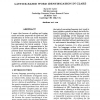Free Online Productivity Tools
i2Speak
i2Symbol
i2OCR
iTex2Img
iWeb2Print
iWeb2Shot
i2Type
iPdf2Split
iPdf2Merge
i2Bopomofo
i2Arabic
i2Style
i2Image
i2PDF
iLatex2Rtf
Sci2ools
ACL
1992
1992
Lattice-Based Word Identification in CLARE
I argue that because of spelling and typing errors and other properties of typed text, the identification of words and word boundaries in general requires syntactic and semantic knowledge. A lattice representation is therefore appropriate for lexical analysis. I show how the use of such a representation in the CLARE system allows different kinds of hypothesis about word identity to be integrated in a uniform framework. I then describe a quantitative evaluation of CLARE's performance on a set of sentences into which typographic errors have been introduced. The results show that syntax and semantics can be applied as powerful sources of constraint on the possible corrections for misspelled words.
| Added | 06 Nov 2010 |
| Updated | 06 Nov 2010 |
| Type | Conference |
| Year | 1992 |
| Where | ACL |
| Authors | David M. Carter |
Comments (0)

